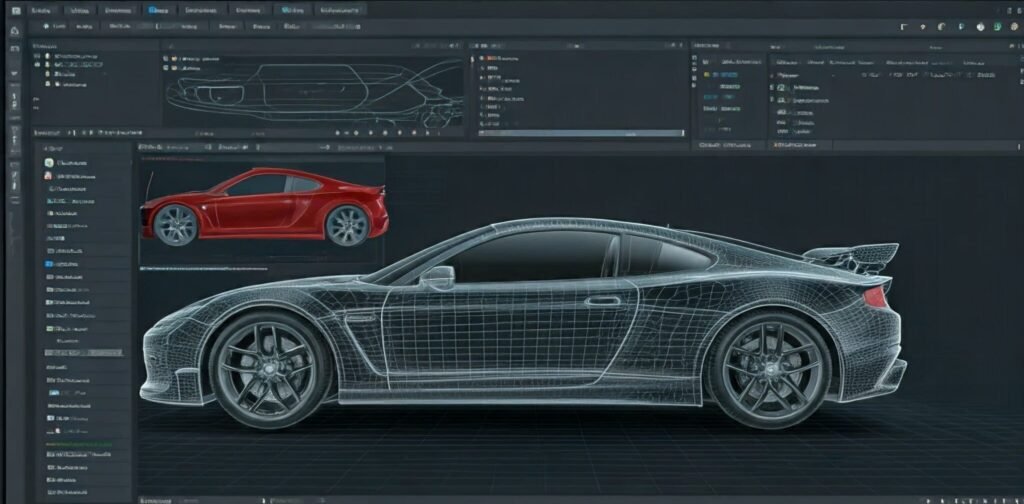Imagine designing products without ever building a physical prototype. 3D modeling makes this possible, streamlining the design process, reducing costs, and improving product quality. Learn how this technology is revolutionizing industries from automotive to aerospace.
Introduction
In today’s fast-paced and competitive market, product design and development play a crucial role in determining a company’s success. Traditional methods often involved lengthy prototyping cycles, high costs, and potential design flaws. However, the advent of 3D modeling has revolutionized this process, offering unprecedented efficiency, accuracy, and innovation.
This article will delve into how 3D modeling is transforming product design and development. We’ll explore the key benefits, best practices, and real-world applications of this transformative technology.
The Power of 3D Modeling
3D modeling involves creating a digital representation of an object in three dimensions. This technology allows designers to visualize and manipulate products before they are ever physically produced. By doing so, it offers several significant advantages:
- Enhanced Visualization: 3D models provide a comprehensive view of a product from all angles, making it easier to identify potential design flaws and make informed decisions.
- Rapid Prototyping: Physical prototypes can be created quickly and iteratively based on 3D models, allowing for rapid design refinement and testing.
- Cost Reduction: By reducing the need for physical prototypes and minimizing design errors, 3D modeling can significantly lower development costs.
- Improved Collaboration: 3D models can be shared and reviewed by multiple stakeholders, fostering better communication and collaboration throughout the design process.
- Increased Innovation: 3D modeling enables designers to experiment with different concepts and explore unconventional designs, leading to more innovative products.
Key Best Practices for 3D Modeling
To maximize the benefits of 3D modeling, it’s essential to follow certain best practices:
- Define Your Product Clearly: Before starting the design process, have a clear understanding of the product’s purpose, features, and target market.
- Leverage Existing Libraries: Utilize pre-built templates and libraries of standard parts to save time and ensure consistency.
- Keep Designs Simple: Avoid overly complex designs that can be difficult to manufacture and assemble.
- Document Thoroughly: Clearly label all parts, dimensions, and materials to ensure accurate manufacturing and assembly.
Real-World Applications of 3D Modeling
3D modeling is being used across a wide range of industries to streamline product design and development. Here are some notable examples:
- Automotive: Car manufacturers use 3D modeling to design everything from engines and transmissions to the exterior body. This technology enables them to optimize designs for performance, fuel efficiency, and safety.
- Aerospace: The aerospace industry relies on 3D modeling to create highly detailed models of aircraft components and simulate their performance under various conditions.
- Consumer Electronics: Manufacturers of smartphones, tablets, and other electronic devices use 3D modeling to design sleek and functional products that meet consumer demands.
- Medical Devices: 3D modeling is used to design and manufacture life-saving medical devices, such as prosthetics and surgical instruments.
Implementing 3D Modeling in Your Organization
To successfully integrate 3D modeling into your product design and development process, consider the following tips:
- Invest in Training: Ensure that your design team is well-trained in 3D modeling software and best practices.
- Establish Design Standards: Create clear guidelines for 3D modeling, including file naming conventions, layer structures, and documentation requirements.
- Utilize a Data Management System: Implement a robust system to manage and store 3D models efficiently.
- Foster Collaboration: Encourage open communication and collaboration between design and engineering teams.
Conclusion
3D modeling has emerged as a transformative technology that is revolutionizing product design and development. By streamlining the design process, reducing costs, and improving product quality, it is helping companies stay competitive in today’s market. By following best practices and leveraging the power of 3D modeling, organizations can create innovative and successful products that meet the needs of their customers.
Check out more helpful tips on “The Weekly 5 Blog”.
OFFICIAL WEBSITE: https://InfinitySKS.com
CONTACT US: Sales@infinitysks.com
SOCIAL MEDIA:
- Facebook: https://facebook.com/infinitysks
- Instagram: https://instagram.com/infinitysks
- YouTube: https://youtube.com/@angellopezlive
- Twitter/X: https://twitter.com/infinitysks
- Pinterest: https://pinterest.com/InfinitySks
- Tumblr: https://tumblr.com/infinitysks

